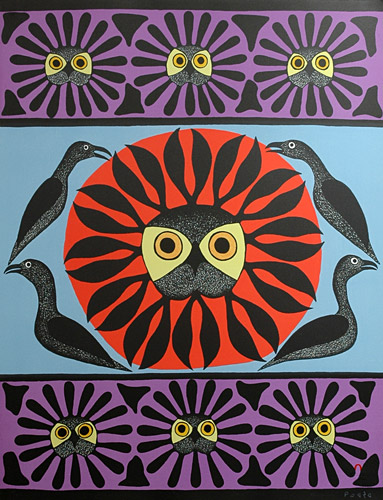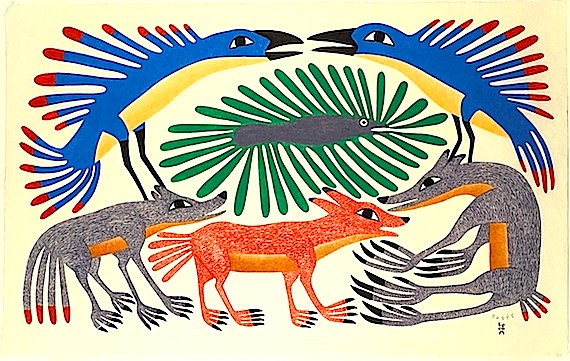ᕿᓐᓄᐊᔪᐊᖅ ᐋᓯᕙᒃ / Kenojuak Ashevak: Inuit Artist Pioneer
Posted: January 8, 2014 Filed under: English, IMAGES, Inuktitut Comments Off on ᕿᓐᓄᐊᔪᐊᖅ ᐋᓯᕙᒃ / Kenojuak Ashevak: Inuit Artist Pioneerᕿᓐᓄᐊᔪᐊᖅ ᐋᓯᕙᒃ (1927-2013)
Kenojuak Ashevak was born in 1927 at the Inuit camp of Ikirasaq on Baffin Island in the North West Territories of Canada. She died exactly one year ago today – January 8th – and we are honouring her now, one year later, because ZP did not ‘post’ during the month of January 2013.
.
One of the first women to make drawings in Cape Dorset during the 1950s, Kenojuak used graphite, coloured pencils and felt-tip pens. With the assistance of Inuit art promoter James Houston, Kenojuak made the transition to soapstone-cut print-making. Her first such print dates from 1959 and is called Rabbit Eating Seaweed. It is based on a needle-work and appliqué design she had made on a sealskin bag. Kenojuak would draw freely, with confidence in line and form, then would have her drawings transferred/cut into the print stones by one of the stone-cutters at the new West Baffin Eskimo Co-operative Workshop (“Senlavik”) which started up in 1959. After the stone-cutter had completed his incisions she would then apply one or two colours of inks to the printing surface. Sometimes the strong arms of Eegyvudluk Pootoogook would help apply the right paper-upon-stone pressure to complete the print. Kenojuak’s The Enchanted Owl, from 1960, is one of the most famous Canadian artworks internationally – instantly recognizable and emblematic of the 1960s and an “Idea” of The North.
.
Kenojuak was married three times and bore eleven children by her first husband, a hunter named Johnniebo Ashevak (1923-1972). At the time of her death from lung cancer in 2013, she was living in a wood-frame house in Kinngait (formerly Cape Dorset), Nunavut. A cheerful personality, Kenojuak was always humble about her artistic success, and thankful for the “gift” of her talent.

The sealskin bag made by Kenojuak in 1958 and from which she drew the inspiration for her first print_Rabbit Eating Seaweed
. . . . .



















